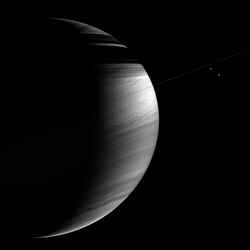
Saturn crescent with Mimas, Rhea and Tethys. Image credit: NASA/JPL/SSI. Click to enlarge
This view of Saturn shows a thick crescent of the planet bathed in sunlight with the rest in shadow. Three moons are visible in this photograph: Mimas, Ryea and Tethys. Cassini took this photograph on March 11, 2006 when it was approximately 2.8 million kilometers (1.8 million miles) from Saturn.
The tilted crescent of Saturn displays lacy cloud bands here along with a bright equatorial region and threadlike ring shadows on the northern hemisphere.
Three moons are visible here. Mimas (397 kilometers, or 247 miles across) at left and faint, is aligned with the ringplane. At right are Rhea (1,528 kilometers, or 949 miles across, at top) and Tethys (1,071 kilometers, or 665 miles across, below Rhea).
The image was taken in polarized infrared light with the Cassini spacecraft wide-angle camera on March 11, 2006, at a distance of approximately 2.8 million kilometers (1.8 million miles) from Saturn. The image scale is 166 kilometers (103 miles) per pixel.
The Cassini-Huygens mission is a cooperative project of NASA, the European Space Agency and the Italian Space Agency. The Jet Propulsion Laboratory, a division of the California Institute of Technology in Pasadena, manages the mission for NASA’s Science Mission Directorate, Washington, D.C. The Cassini orbiter and its two onboard cameras were designed, developed and assembled at JPL. The imaging operations center is based at the Space Science Institute in Boulder, Colo.
For more information about the Cassini-Huygens mission visit http://saturn.jpl.nasa.gov . The Cassini imaging team homepage is at http://ciclops.org .
Original Source: NASA/JPL/SSI News Release
